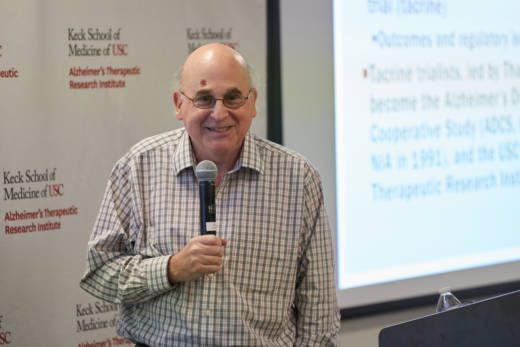Dr. David Knopman, a clinician and researcher in cognitive disorders at the Mayo Clinic, thinks looking for drugs outside of amyloid targets “is critically important for the field." He mentions targeting the tau protein as an approach researchers are excited about.
"Even if an anti-amyloid agent did work," he says, "there must be other processes downstream that could be more easily targeted or effective than amyloid.”
Amyloid, But Early
But according to Aisen, solanezumab is not dead yet. The problem with past trials, he believes, is they did not get to patients early enough.
“We strongly believe the effect will be greater in prevention trials that are underway, probably about 15 years earlier in the course of Alzheimer’s than the studies that were completed," he says.
This new crop of trials — five in total — have either recently begun or will soon get underway. Each trial is aiming to treat and prevent Alzheimer’s by targeting amyloid before cognitive symptoms ever develop.
Aisen is one of the lead scientists for the Anti-Amyloid Treatment in Asymptomatic Alzheimer’s (or A4) trial. As part of the trial, solanezumab will be given to seniors ages 65 to 85 who have elevated levels of amyloid plaque but no outward symptoms. Some of the 1,150 participants will receive the drug, an antibody that cleans up free-floating amyloid, over the course of four-and-a-half years, while others will get a placebo.
The participants will be monitored throughout for changes in memory and cognition, along with lab tests and brain imaging to detect physiological changes.
Another study known as the EARLY trial is still recruiting participants, ages 60 to 85, also healthy but at risk for Alzheimer's due to an elevated amyloid level or other factors. The treatment period lasts for four-and-a-half years with a drug that hampers the production of the protein. Both the A4 and the EARLY trials are coordinated by the Alzheimer’s Therapeutic Research Institute, which Aisen directs.
The Banner Alzheimer’s Institute is conducting a trial on a different drug that also blocks the production of amyloid. Its Alzheimer’s Prevention Initiative program is still recruiting 1,300 participants worldwide for the trial, which will last 5 to 8 years. Known as the API Generation study, individuals ages 60 to 75 who are healthy but have a genetic profile that increases their risk for Alzheimer’s will be treated with one of two drugs. One targets amyloid in the brain for removal, and the other acts in a unique way that’s analogous to “the body being able to create its own vaccine,” says principal scientist Jessica Langbaum at Banner Alzheimer’s Institute.
Participants are selected based on a genetic risk factor known as APOE4, though they will not be made aware of this if they choose not to, says Langbaum. The study will also provide genetic counseling so that risk profiles aren’t misunderstood as prophecies of disease.
The Banner institute has created a registry called GeneMatch for Alzheimer's studies currently enrolling people. These studies call for subjects as young as 40.
'Either It Works or It Doesn't'
In these three trials, even though the subjects have biochemical markers linked to the disease, the participants will not necessarily wind up with Alzheimer's.
Not so with two other two trials that are looking at a form of early onset Alzheimer’s. These individuals all have one of a few rare genes in which the disease manifests before age 65, usually when people are in their 40s or 50s. About 5 percent of people with Alzheimer's fall into this category.
Will targeting amyloid in the asymptomatic stage keep dementia at bay? That’s the billion-dollar question. But it's going to take several years for the results to trickle in.
Says Knopman: "The amyloid story needs to be finished, and either it works or it doesn't in the current trials."
Dr. Paul Aisen discusses early targeting of amyloid in 2014.

